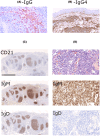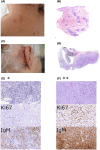Recurrent primary cutaneous marginal zone lymphoma: a comparative study of initial tumours, recurrences, and outcomes in 61 patients
- PMID: 39628350
- PMCID: PMC11903116
- DOI: 10.1111/his.15377
Recurrent primary cutaneous marginal zone lymphoma: a comparative study of initial tumours, recurrences, and outcomes in 61 patients
Abstract
Aims: Primary cutaneous marginal zone lymphoma (PCMZL) is considered a lymphoproliferative disorder (International Consensus Classification, ICC) or an overt lymphoma (WHO-HAEM5). Seeking evidence for a reactive process or true lymphoma, we retrieved recurrent PCMZLs from the French Study Group of Cutaneous Lymphoma (GFELC) database.
Methods: Histology, phenotype (light-chain restriction, immunoglobulin, and immune-receptor translocation-associated protein-1 [IRTA1] expression) and B-cell clonality at diagnosis and recurrence were compared according to recurrence site (local, locoregional, or distant) and outcomes.
Results: Initial lesions of the 61 patients (mean age 52) were mostly isolated on the trunk (48%) and classified T1 (70%). Times to first recurrence for local, locoregional, and distant recurrences, were 20, 29, and 37 months, respectively. Light-chain restriction type did not differ significantly between local/locoregional recurrences and distal recurrences (P = 0.06; n = 60). The same B-cell clones were identified for 23/42 local/locoregional recurrences, while 5/19 distant recurrences showed different clonal profiles (P = 0.0003). No tumour expressed IRTA1. Fifty-eight tumours were heavy-chain (IgG/IgG4) class-switched PCMZLs and 3 IgM+/IgD- PCMZLs. All IgM+ tumours underwent either transformation (skin or brain) into diffuse large B-cell lymphomas (DLBCLs) and extracutaneous spreading.
Conclusion: As suggested by WHO-HAEM5, immunoglobulin phenotype assessment (IgM alongside IgD) appears to be a possible valuable tool in the initial diagnosis of PCMZL to differentiate between the indolent class-switched PCMZL (IgM-negative) and IgM+ (IgD-) PCMZL, which has an uncertain prognosis. The variation in B-cell rearrangements and light chain restriction observed in distant recurrences of PCMZL may suggest different antigen-driven stimulation processes.
Keywords: heavy‐chain class‐switched; primary cutaneous marginal zone lymphoma; primary cutaneous marginal zone lymphoproliferative disorder; transformed marginal zone lymphoma.
© 2024 The Author(s). Histopathology published by John Wiley & Sons Ltd.
Conflict of interest statement
The authors have no conflicts of interest to disclose.
Figures



References
-
- Krenitsky A, Klager S, Hatch L, Sarriera‐Lazaro C, Chen PL, Seminario‐Vidal L. Update in diagnosis and Management of Primary Cutaneous B‐cell lymphomas. Am. J. Clin. Dermatol. 2022; 23; 689–706. - PubMed
-
- Servitje O, Muniesa C, Benavente Y et al. Primary cutaneous marginal zone B‐cell lymphoma: Response to treatment and disease‐free survival in a series of 137 patients. J. Am. Acad. Dermatol. 2013; 69; 357–365. - PubMed
-
- Senff NJ, Hoefnagel JJ, Jansen PM et al. Reclassification of 300 primary cutaneous B‐cell lymphomas according to the new WHO–EORTC classification for cutaneous lymphomas: Comparison with previous classifications and identification of prognostic markers. JCO 2007; 25; 1581–1587. - PubMed
-
- Harris E, Sindel A, McConnell I, Clark W, Chesney A, Yazbeck V. Transformation from indolent primary cutaneous marginal zone lymphoma to aggressive primary cutaneous diffuse large B‐cell lymphoma: A rare case and review of the literature. Blood 2019; 134; 5266.
-
- Gerami P, Wickless SC, Rosen S et al. Applying the new TNM classification system for primary cutaneous lymphomas other than mycosis fungoides and Sézary syndrome in primary cutaneous marginal zone lymphoma. J. Am. Acad. Dermatol. 2008; 59; 245–254. - PubMed
Publication types
MeSH terms
LinkOut - more resources
Full Text Sources
Medical
Research Materials

